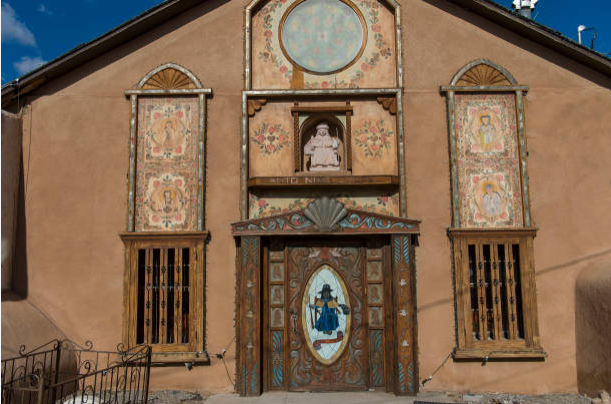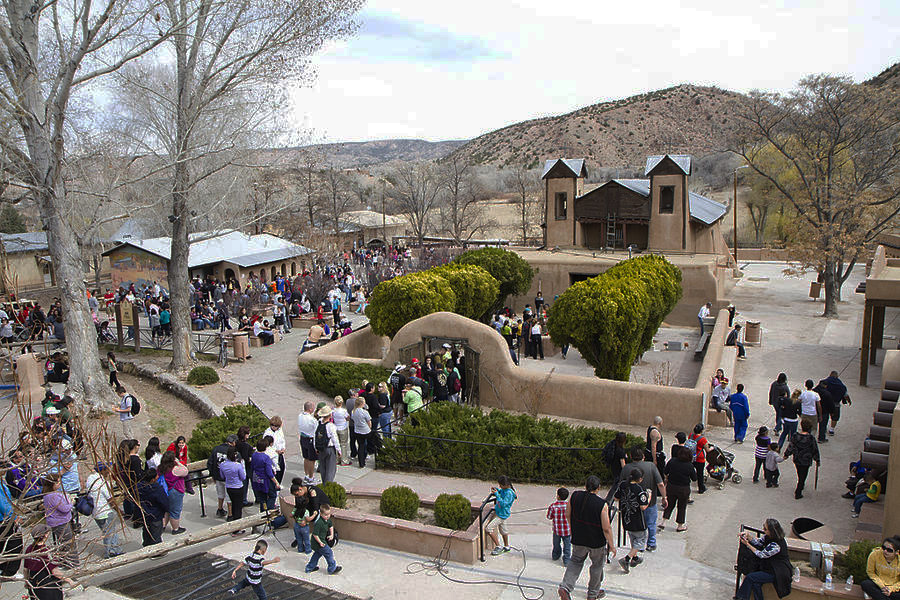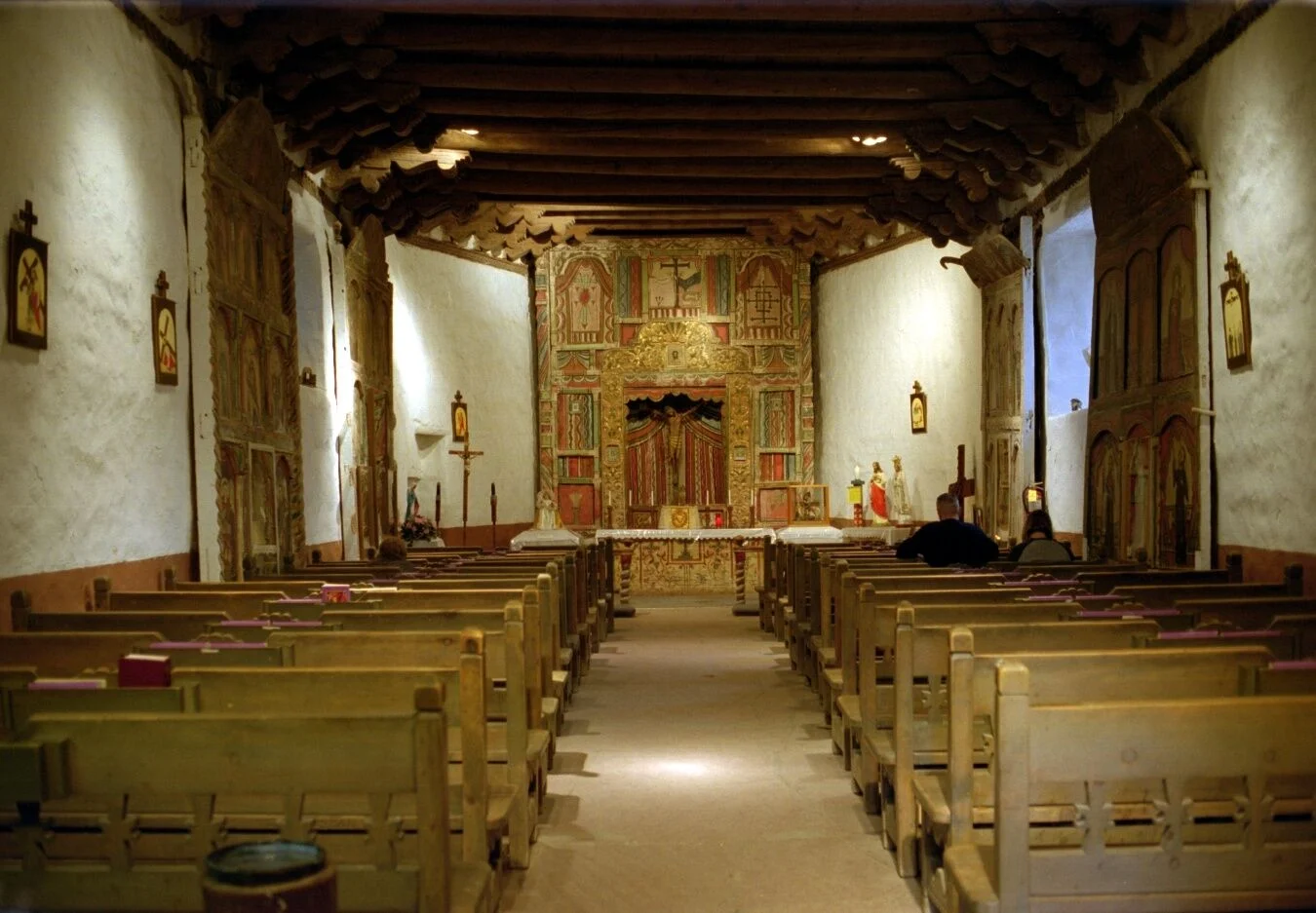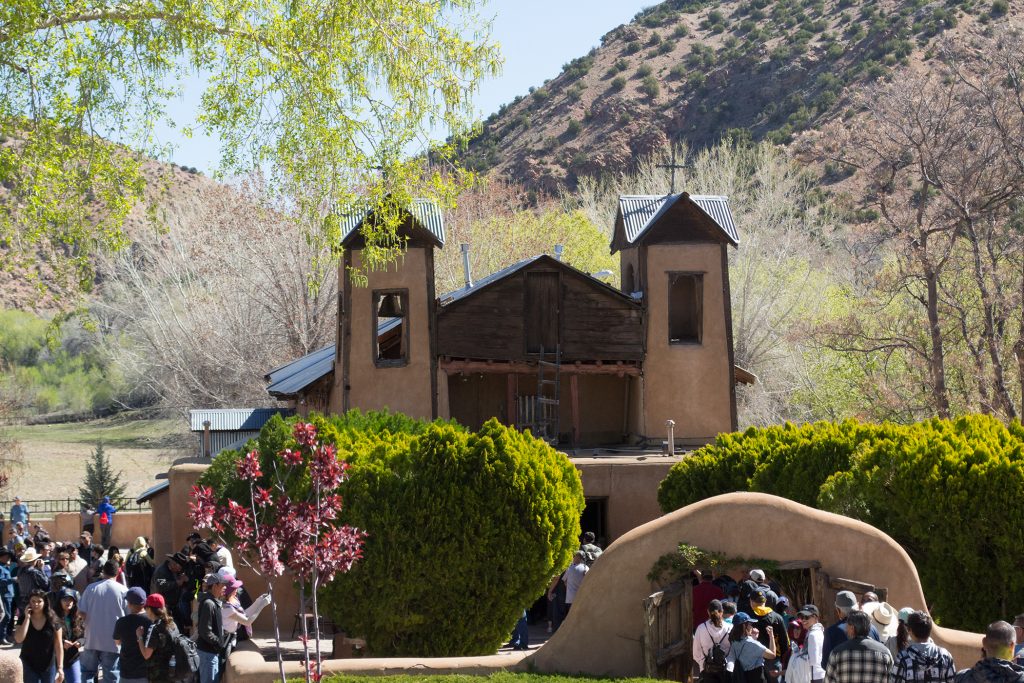
Located in New Mexico, the Santuario de Chimayó is a pilgrimage destination that has profoundly touched the lives of thousands of believers, not only from the United States but from all over the world. Known for its healing miracles and its rich history of devotion, this place has witnessed numerous testimonies of faith and hope.
In this guide, we will explore the significance of Chimayó in Christian pilgrimages, as well as its history, symbolism, and what makes this place so special for believers.
This sanctuary is one of the most revered destinations in the United States for the faithful and an important site for Christian pilgrimages.
Its origin dates back to the 19th century when it was built on a site that, according to tradition, was already considered sacred by the natives. The story tells that around 1810, a farmer named Bernardo Abeyta discovered a cross buried in the ground, which was interpreted as a divine sign.
Moved by this discovery, Abeyta and the local community decided to erect a small sanctuary to safeguard the cross, thus giving birth to the Santuario de Chimayó. Devotion grew rapidly, and healing miracles began to be documented, attracting more faithful seeking spiritual and physical relief.
This phenomenon is reminiscent of other places such as the Santuary of Guadalupe in Mexico, where the faith of pilgrims plays a fundamental role in the religious experience.
One of the most significant beliefs in Chimayó is the healing power of its soil, which many visitors collect in small bags. This soil, known as the sacred pit, is said to have miraculous properties, and healing testimonies have fueled the sanctuary’s fame over the years.
The tradition of taking this soil as a symbol of faith has made the place a center of devotion of great importance.
It is believed that this soil, found inside what is now a chapel, has healing properties, making Chimayó a place of faith and hope, similar to other sanctuaries like Fátima or the Holy Land in Jerusalem, where believers seek spiritual peace and healing.
The story of this miraculous soil dates back to the first accounts of local inhabitants, who claimed that miracles occurred upon contact with it. For the faithful, Chimayó’s soil symbolizes divine power and the presence of God, uniting Christian faith with a tangible connection through nature.
Many pilgrims share testimonies of healing and health improvements after using this soil. Some apply a small amount to their bodies, while others take small bags for family and friends. To preserve this soil, a careful management system is in place, and the soil is regularly replenished, maintaining its symbolism and preventing depletion.
The Catholic Church has recognized its significance in Christian devotion, highlighting the sanctuary as a place of pilgrimage that not only heals bodies but also the spirit of those who visit.

This is a deeply rooted tradition in the heart of New Mexico, especially during Holy Week, when thousands of believers walk long distances to reach this sacred place. Each year, more than 300,000 faithful visit the sanctuary.
Chimayó has become a site of faith, hope, and healing, with devotion reminiscent of sanctuaries like that of the Virgin of Lourdes, where pilgrims seek spiritual and physical solace.
Below, we highlight the most important aspects of this annual pilgrimage.
The Holy Week pilgrimage to the Santuario de Chimayó traces its origins to early 19th-century local beliefs. As the first healing miracles were reported, devotion grew rapidly, attracting people from various regions seeking relief from their ailments and giving thanks for blessings received.
Today, this pilgrimage has grown significantly and is nationally recognized, with more than 30,000 pilgrims participating each year. Walking to the sanctuary, especially on Good Friday, has become a symbol of faith and penance, representing a direct connection with God for many.
For pilgrims, reaching this place is a deeply spiritual experience. Many choose to walk long distances from their hometowns, while others travel from different parts of the United States.
The most common pilgrimage route begins in the city of Española, covering approximately 15 kilometers to the sanctuary. This journey can be undertaken by people of all ages, each step serving as an act of faith.
The motivations for making this pilgrimage vary. Some seek physical healing, trusting in the power of Chimayó’s sacred soil, while others do so as a sign of gratitude for received blessings. Some walk in honor of loved ones or as part of a personal promise.
Regardless of the reason, the journey strengthens the faith of participants and fosters a sense of community and brotherhood among them.
Holy Week in Chimayó is filled with religious activities and moments of reflection that enrich the visitors’ experience.
During these days, the sanctuary offers masses, confessions, and special blessings for pilgrims, who actively participate in each rite. The ceremonies are accompanied by hymns and prayers, creating an atmosphere of devotion and reverence that moves everyone present.
Good Friday is the most attended day, and the atmosphere is filled with religious fervor as pilgrims, exhausted but full of faith, arrive at the sanctuary. These religious celebrations not only reinforce the spiritual commitment of attendees but also highlight the richness of Christian traditions.

This sanctuary also stands out for its rich architecture and sacred art, which capture the devotion and history of the Christian faith in New Mexico. Built in a traditional Hispanic style, it reflects colonial influence, with adobe walls, wooden beam ceilings, and a simple yet meaningful structure for those who visit each year.
The interior of the sanctuary is adorned with religious iconography, including paintings and sculptures of saints, the Virgin Mary, and biblical scenes, all meticulously handcrafted. These elements reflect the influence of local artisans, who have integrated their culture and faith into every detail.
The image of Our Lord of Esquipulas is particularly venerated in the sanctuary, as it represents the Black Christ and is a major object of devotion for pilgrims. Among the most valuable elements are relics and devotional objects, including crosses, rosaries, and other religious items left as offerings by pilgrims over the years.
The sanctuary also houses traditional artworks, such as retablos and ex-votos, which narrate stories of miracles and gratitude for granted favors.
Visiting this place is a deeply spiritual experience, and to make the most of it, proper planning is essential.
The sanctuary is located in the picturesque Chimayó Valley, about 40 kilometers from the city of Santa Fe. It can be reached by car via Route 76 or through organized tours departing from Santa Fe and Albuquerque.
The sanctuary is open year-round, but visiting hours may vary by season, so checking in advance is recommended. Generally, the opening hours are from 8 AM to 5 PM.
During Holy Week, the sanctuary receives thousands of visitors, and the roads fill with pilgrims walking the route as an act of faith. On these special dates, it is advisable to arrive early to avoid the largest crowds and enjoy the spiritual atmosphere in peace.
Upon entering, it is important to respect the sanctuary’s rules, such as maintaining silence and refraining from consuming food inside. It is also recommended to dress appropriately and respectfully, in line with the solemnity of the place.
For those who wish to take a souvenir, visitors are allowed to collect a small amount of Chimayó’s famous sacred soil.
Regarding accommodation, the area offers various options, from cozy inns to hotels in nearby cities like Española and Santa Fe. Additionally, the surroundings feature restaurants and local craft shops, where visitors can enjoy traditional cuisine and purchase unique souvenirs.

The community of Chimayó maintains a close bond with the sanctuary, participating in its preservation and organizing annual festivities. Locals assist with pilgrimage logistics and visitor care, creating a welcoming and supportive environment that enriches the spiritual experience.
Additionally, many residents offer water and refreshments to pilgrims during Holy Week, a gesture symbolizing mutual support and unity in faith.
The preservation of the sanctuary and its surroundings is also the result of collaboration with organizations dedicated to maintaining historic sites. This effort focuses on conserving the original adobe structure as well as the natural elements surrounding the site, respecting both its spiritual and ecological significance.
The Chimayó Sanctuary is also a valuable cultural heritage site for the descendants of New Mexico’s indigenous and colonial communities. Stories and legends about Chimayó’s origins have been passed down through generations, preserving the essence of local traditions.
The annual influx of visitors to the Chimayó Sanctuary benefits the local economy, boosting small businesses, craft shops, and restaurants in the region. This cultural and economic exchange strengthens the community’s identity, turning faith into a driver of local development and allowing visitors to experience the authentic hospitality and culture of northern New Mexico.
Chimayó is a small town known for its deep cultural roots, reflected in its customs, festivities, and the warmth of its inhabitants. Visitors find an authentic connection to New Mexico’s history and traditions, making it a unique stop on any pilgrim’s journey.
One of the most notable aspects is its local craftsmanship. The town is famous for its traditional weaving, especially wool rugs and blankets handwoven using ancestral techniques passed down through generations.
Its gastronomy is also noteworthy, featuring dishes that reflect both Hispanic and Native heritage.
One of the most famous ingredients is Chimayó chile, known for its unique flavor and artisanal cultivation in the valley.
Stay Connected with WayHoly
Discover your perfect pilgrimage and be the first to know about new journeys. By subscribing to our newsletter, you’ll receive the latest updates on pilgrimages, exclusive offers, and spiritual resources to enrich your faith journey.
Don’t miss the opportunity to deepen your connection with God and lead others on their path to spiritual renewal. Join us today and become an instrument of His Will through WayHoly!
“To upload your pilgrimage, please choose one of our plans and create an account, or log in if you’re already a member. Join us in guiding others on their spiritual journey.”